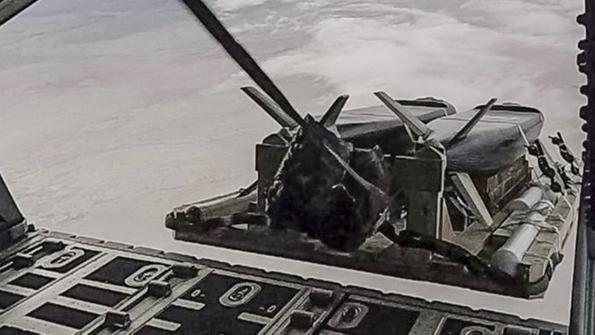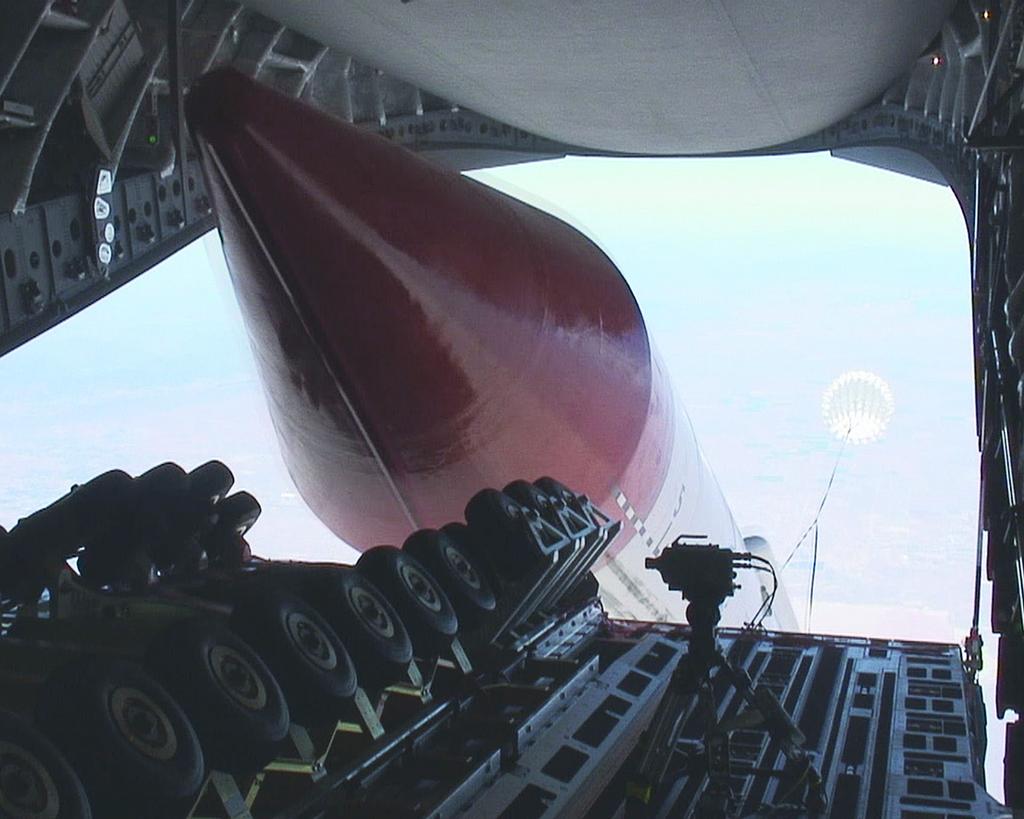
An "Arsenal Plane" has rapidly emerged as a short-term priority for the U.S. Air Force, but an internal debate continues over the type of aircraft to use, potentially affecting the service’s existing command structure and the Northrop Grumman B-21 program.
- Air Force Research Laboratory has demonstrated a new Cleaver munition
- "Arsenal Plane" prototyping budget is in discussion
A proposal to modify Lockheed C-130s and Boeing C-17s to air-drop existing and new long-range munitions is now favored as a short-term solution by the Air Force Warfighting Integration Capability (AFWIC) office, which is charged with developing new operational concepts by the Air Staff.
Air Force Global Strike Command (AFGSC), which has responsibility for the bomber fleet and inventory of intercontinental ballistic missiles, prefers developing a new aircraft optimized for the mission, rather than seeking to borrow strike capacity from an already overburdened air mobility fleet.
Neither proposal is endorsed by the Mitchell Institute, the think tank arm of the Air Force Association (AFA). In a prepublication report obtained by Aviation Week, Col. (ret.) Mark Gunzinger, the institute’s director of Future Aerospace Concepts and Capability Assessments, argues that the most cost-effective solution is to buy more B-21 bombers rather than invest in more long-range munitions to support the Arsenal Plane concept.
All the parties involved agree that the airborne component of the Air Force’s long-range strike capability is inadequate, even after Northrop Grumman delivers at least 100 B-21s, which are expected to replace a fleet of 20 Northrop B-2s and 62 Rockwell B-1Bs and operate alongside about 75 Boeing B-52s.
“What we see is that no matter how big our bomber force is, the capacity that the Joint Force needs is always more and more,” says Maj. Gen. Clinton Hinote, deputy director of the AFWIC, which develops new operational concepts on the Air Staff.
The Air Force’s latest estimate of the requirement calls for a fleet of at least 220 bombers, Gen. Timothy Ray, the head of AFGSC, told reporters in early April.
According to a fleet forecast in the Mitchell Institute report, the Air Force inventory could decline to about 120 bombers by 2032 as the B-2 and B-1B fleets are retired.
Gunzinger, a former bomber pilot, forecasts the Air Force will order about 120 B-21s by 2040. Combined with 75 B-52s, however, the fleet would still be about 30 aircraft short of the minimum deemed required by the Air Force today. Closing that gap—either by loading long-range munitions on existing airlifters, developing a new aircraft for that purpose or buying more B-21s—is driving the internal debate.
At its core, the debate is over cost-effectiveness and capacity. A stealthy bomber, such as the B-21A, is more expensive than an Arsenal Plane but needs less expensive, unpowered munitions because they can be released closer to the target. On the other hand, the B-21A remains early in the development phase, so Northrop may need more than a decade to deliver a significant number of aircraft.
Various forms of the Arsenal Plane concept have been discussed since the 1970s. As former President Jimmy Carter’s administration considered options to the Rockwell B-1A, the Defense Department briefly proposed the Cruise Missile Carrier Aircraft—a Boeing 747 modified to launch cruise missiles.
The idea reemerged nearly 30 years later as the program that led to the B-21A began taking shape. In 2006, the Congressional Budget Office considered an Arsenal Aircraft based on a Boeing C-17 loaded with a supersonic cruise missile and concluded that it would be less effective than a penetrating bomber and require an extra $3.5 billion to order more C-17s.
As the Pentagon locked in requirements for the B-21A program four years later, an Air Force-funded study by Rand compared the costs of a penetrating bomber versus an Arsenal Plane concept. If the U.S. military engages in at least 20 days of airstrikes over a 30-year period, the 2010 study concluded a penetrating bomber would be more affordable than the required investment in the Arsenal Plane.
Even though the Air Force awarded Northrop a contract to develop the B-21A in October 2015, however, the debate has continued. Will Roper, then director of the Strategic Capabilities Office within the Office of the Secretary of Defense, unveiled an Arsenal Plane concept in February 2016, showing a Lockheed C-130-like aircraft dispensing palletized munitions.
A year later, Roper became assistant secretary of the Air Force for acquisition, technology and logistics, and the Arsenal Plane moved to the Air Force Research Laboratory (AFRL). In January, the AFRL completed the first test of a new palletized munition dropped by an MC-130J. A picture of the new weapon—the Cargo Launch Expendable Air Vehicles with Extended Range (Cleaver)—showed six munitions on each pallet. A follow-up test involving an airdrop from C-17s was scheduled in April.

The Cleaver testing satisfied AFRL that C-130s and C-17s could adapt one of the core capabilities for both aircraft: airdrop. The C-17 also has demonstrated the capability of releasing air-launched rockets from the cargo bay. In 2006, a C-17 was used to air-drop a launcher for a hypersonic boost-glide missile. The aircraft also is used by the Missile Defense Agency to test interceptors by dropping surrogates of medium-range ballistic missiles.
The AFRL completed the tests weeks before the Defense Department completed plans for the fiscal 2022 budget proposal.
“We are in discussions right now about how we proceed to prototyping and fielding,” Hinote says.
For AFWIC, arming C-130s and C-17s with long-range weapons is attractive because it can increase munition capacity significantly in the near term.
“It’s all about capacity and that you’ve got to create enough capacity so that long-range punch is really a punch,” Hinote says. “This is why we think that there’s a real possibility here for using cargo platforms to be able to increase the capacity of fires.”
Not everyone agrees with that approach. As the commander of the Air Force’s bomber fleet, Ray told reporters in early April that he does not want a commander to have to choose between using a C-17 for either weapons or airlift capacity.
“When you think about using a cargo plane, you’re in competition for other airlift requirements,” Ray said. “I think the Arsenal Plane concept is probably better defined as more of a clean-sheet approach to a platform that can affordably and rapidly fill the gap.”
While Hinote and Ray debate whether an existing or clean-sheet design is better for an Arsenal Plane, some airpower experts still reject the idea that anything less than a stealthy bomber is adequate.
Instead of lobbing long-range missiles, the B-21 is designed to get close enough to a target to use short-range, direct-attack weapons. Such munitions do not need to carry fuel and propulsion systems and so they can be smaller in proportion to the size of their warhead.
“Size matters, since the number of weapons that can be delivered per aircraft sortie decreases as weapon size increases,” Gunzinger wrItes in the Mitchell Institute report.
In addition to capacity, Gunzinger also questions the cost of an Arsenal Plane’s required inventory of long-range munitions versus a bomber’s more affordable, precision-guided bombs. A conflict with China or Russia could generate a massive list of targets.
“Using tens of thousands of very long-range standoff weapons that cost a million dollars or more each is simply not affordable,” Gunzinger writes.






Comments
So if you accept the premise that some of the B-21's will be targeted, and no low observable aircraft is completely undetectable; it will be necessary to balance B-21 losses against high value targets with 'cheap' bombs against using LRSO hypersonic missiles to destroy them.
Using the S-400 system as an example, the performance of these will get better as time passes, and they would HAVE to be disabled in the first hours of any conflict. I'm just glad that will be someone else's decision!
One other consideration is the cost of use. The less a potential conflict will cost, dollars or lives, the lower the motivation to use other means to defuse or find accommodation to avoid it. One of the refrains for having a powerful military is its very presence reduces the need for military action. This would indicate that having to use a system is in effect a failure of that system. Making a system that is expensive to develop and own, but inexpensive to employ will encourage it use. Is that our goal?
First start with targets over time. What weapons can kill those targets? I somehow don't thing JDAMs or SDBs will live after launch from a B-21, regardless of how stealthy it is, when aimed at a SAM complex or other highly defended target. So, JASSM-ER? Maybe so. They're not cheap, $1.25M each. AARGM?, not cheap either, $900K each. Hypersonic boost-glide weapons, somehow I don't think a million will buy one.
The Air Force should start with the target array, program to buy the weapons to kill them, then the bomb trucks to carry them to the launch point. -Then- figure out surge options to cope with a bunch of targets and a shortage of bomb trucks. Planning for a couple of hundred B-21s is fine but if there are no weapons in the bunkers and if the Chinese start the war early, as the USN suspects will happen, being able to roll existing weapons in to C-17s or Here's A Thought, some of those parked transports from the airline industry without customers, to meet a peak need may save our bacon.
With many airliners being retired, these can be converted into Arsenal
Planes that can be easily supported by commercial MRO.
There are also many existing missile designs that can be modified like the Tomahawk to become stealthier and faster. This will turn on its head Chinese A2AD strategy.
Aircraft carriers can also become Missile/Aircraft Carriers.
The 12 would be brought into flying condition and incorporate the various planned and ongoing modernization and upgrades, in addition to the re-engining once an engine is selected.
Two rejuvenated H's would be dedicated to T&E needs, replacing two of the four currently in the test fleet, allowing the active or reserve forces to increase by two. The other 10 would go into the active fleet with 10 H's being taken out for re-engining. Therefore no reduction in the active 75 would occur, and likely an increase by two.
As 10 H's are upgraded/re-engined at a time the active/reserve forces would be maintained until the last 10 are done which would then result in a fleet increase to 85 plus the two T&E H's.
Adding 10 H's to the fleet would likely be done at a cheaper price than one planned B-21. The remaining gap would be filled with 20 additional B-21s.